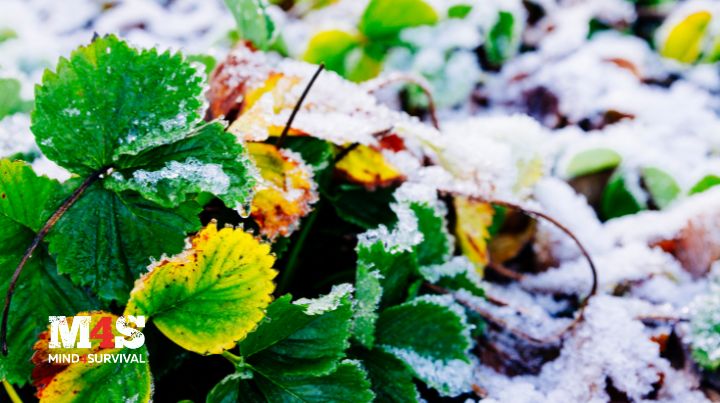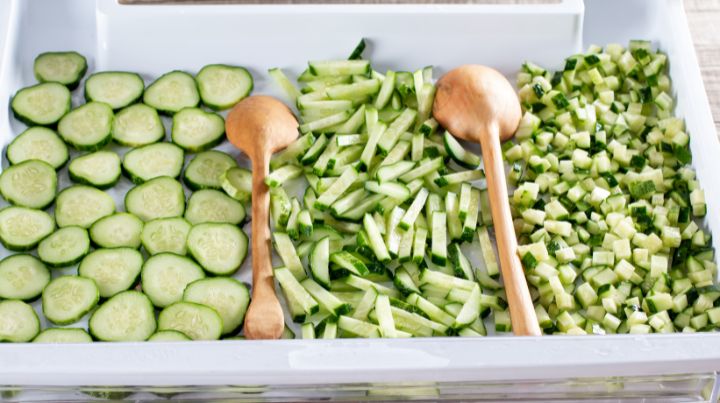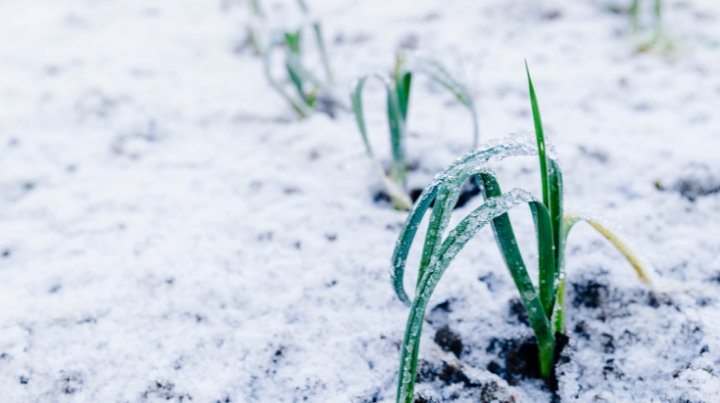Winter Garden Preps

Gardening season is winding down for most of us. As the nights become colder, you might be wondering when it’s time to pull up what. I began my gardening journey years ago with the mentality that freezes meant the end of the season, but in reality, the end is much more gradual.
These days, I have two large vegetable gardens and fruit trees. I have to organize harvesting because it’s not physically possible to get everything picked at once. So, I’ve got my plants divided into different groups.
Extremely Sensitive
With my peppers, cucumbers, ground cherries, and green beans, I harvest as much as possible before temperatures drop below 40. Cucumbers typically stop producing with cooler nights anyway. Still, on the High Plains, we can have very erratic temperature swings along with high winds that can freeze plants even if we don’t officially have a frost. Cucumbers and green beans, climbing up their poles, are particularly prone to this.
If we will only be sub-35 for a few hours and then return to moderate temperatures (which is not unusual in September and October), I may just cover plants with a tarp or buckets. Often, we’ll have one or two days of cold temperatures and then two or three more weeks of pleasant temperatures; if I can get the plants through a few days of cold, I can often extend my harvest season by a few weeks.
Sensitive
Tomatoes are not as hyper-sensitive as peppers, but the plants still die if exposed to temperatures below freezing.
However, by the fall, my tomato plants are huge and bushy. If it is only below freezing for a few hours, I will usually just harvest the tomatoes on the edge of the plant that will be first exposed to cold temperatures. We have had a few nights where it has been at or slightly below 32 for three or four hours. The foliage on the edge of the plants dies, but the fruits within the interior, sheltered by more foliage, are perfectly fine.
As with my peppers and cucumbers, if I think that colder temperatures will be short-lived, I will often place a tarp over the tomatoes.
Beets are frost-sensitive, too. Because they don’t do much more growing in the fall, I simply pull them up and either can them or put them in my root cellar as soon as it looks like temperatures will dip below freezing.
Squash and pumpkin are also frost-sensitive. Freezing temperatures will kill the foliage in a fairly short time.
But My Pumpkins Aren’t Ready!
Don’t worry about it. Pumpkins, like tomatoes, ripen off the vine. Just bring them in, away from the frost, and let them ripen on your counter. Perfect storage for pumpkins and winter squash is about 60 degrees. If you have a root cellar, put them on the top shelf, where it is warmest in the fall. Will the taste be quite as exquisite as if it ripened in the garden? No, just like tomatoes are absolutely best when vine-ripened. But, like counter-ripened tomatoes, your house-or cellar-ripened pumpkins and winter squash will still be pretty good.
Along with my vegetables, I also have a grapevine, as well as peach and apple trees. The grapes and peaches ripen when they ripen. If we get an unseasonal frost, I will cover those plants with sheets. Otherwise, they get harvested when they’re ripe.
Apples can hang out on the tree a little longer. Apples on the tree will be just fine if the temperature stays above 28 degrees. Apples can survive slightly colder temperatures for up to about four hours.
For example, if you have a daytime high of 48 degrees, and the hourly forecast looks like it will drop to 26 for a couple of hours early in the morning before rising again, your apples will probably be okay. But if the weather will stay below 28 all day, you’ll want to bring them in beforehand.
Somewhat Hardy
Peas, potatoes, carrots, onions, leeks, and celery are not disturbed by temperatures that dip slightly below freezing. I typically plant my peas and potatoes in the spring, so they get harvested long before fall frosts. A light frost will hurt the foliage of a potato plant, but as long as it doesn’t dip below about 28, as soon as it warms up, the potato plants will recover.
Onions and Leeks
Onions and leeks will suffer foliage damage during a hard frost, so once it’s below 28, I bring them in. Leeks can be buried in straw and covered with a bucket if the temperatures dip below 28 for a longer period. I have left leeks like this for a few weeks at a time. The foliage tips will probably not look good, but the bottom portion of the plant is usually fine.
Carrots and Celery
Carrots and celery should actually not be harvested until they’ve experienced cooler temperatures for the best flavor. As soon as the plants are exposed to freezing temperatures, starch within the plants begins converting to sugar, making frost-touched carrots and celery particularly delicious.
If I have ample storage, I will usually harvest carrots when it looks like temperatures will be below freezing for a day or more, or if the temperature will drop below 25. If I’m short on storage space, which sometimes happens in the fall, I will cover the carrots with straw and then harvest as needed. In my area, average day/night temperatures are roughly 50/20 in November and 45/15 in December. The carrots definitely need to be inside by December, but covering them with straw can buy me a few extra weeks in November to get organized.
I don’t know anyone who grows celery in my part of the country, but celeriac does well. I can actually treat the celeriac like carrots. The foliage will be injured by hard (below 28) frosts, so when it is time for that weather, I cut off the foliage and dry it for use in soups throughout the year. Then I pack the roots in the garden with straw, and as soon as temperatures are consistently below 25 at night, I put the celeriac in the cellar.
Hardy
Some plants just love the cold. And fortunately for us, some of these plants are the most nutritious, too.
Rutabagas grow really well in my climate. Assuming they survive the onslaught of grasshoppers in the summer, they are typically pretty trouble-free and form the base of stews throughout the winter months. The foliage will start to freeze if temperatures drop below 28, but the roots are fine until the soil temperature around them is about 24. This gives me a lot of wiggle room; in my climate, I can usually just pull them as needed until December, when nighttime temperatures regularly drop below 20. After that, I can put them in the root cellar, where they will keep for a few more months.
Rutabagas are members of the Brassica (formerly Cruciferae) family, and this family tends to like the cold. Broccoli, kale, and Brussels sprouts are all untroubled by sub-30 temperatures, assuming that the weather has cooled off somewhat gradually.
Sudden Frost
On the High Plains, we don’t always get gradual. One October, I remember we had an 80-degree day, followed by violent winds and then a drop to 12 degrees overnight. I buried my garden with straw and tarped it. I lost all my sensitive plants, but my carrots, rutabagas, and leeks survived. A drop like that will kill almost anything because the plants are shocked.
However, if the plants have a chance to adjust, brassicas like broccoli and Brussels sprouts will be fine until the temperatures regularly drop below 20ºF. Winter greens, like kale, may be good down to 10 degrees. Reading your seed packets, you will find that some varieties of kale can handle temperatures as low as 5 degrees. With kale, I typically leave it in the garden and see how long it lasts.
Final Thoughts
Well-tended, productive gardens bring a lot of work but also a lot of joy. Aside from the practical advantages of access to healthy food and lower grocery bills, gardening is something almost anyone can do to boost their confidence and feel more in control of their lives.
However, for beginning gardeners, the realities of harvesting, processing, and storage can come as a shock. It is real work and can be overwhelming at first. But you can plan for it! As you become a more competent gardener, your organizational skills will improve, too.
Harvest time is the best time of the year. There is nothing like the satisfaction of a root cellar and freezer full of home-grown foods. Once you strike the right rhythm for your household, the sense of abundance and gratitude during the fall season will become that much more meaningful.
Additional Resources:
Don't Miss Out!
Join the thousands of people who rely on Mind4Survival preparedness advice by subscribing to our FREE newsletter.
- Practical preparedness information
- Zero Spam
- < 0.25% of people unsubscribe




Join Mind4Survival!
Stay informed by joining the Mind4Survival! 100% Secure! 0% Spam!
Follow Us!
Affiliate Disclosure
Mind4Survival is a free, reader-supported information resource. If you make a purchase through our link, we may, at no cost to you, receive an affiliate commission.




Great article. Thank you. I discovered years ago that if I cover my tomato plants in the high desert with wool blankets, I can keep them in the ground until Thanksgiving.